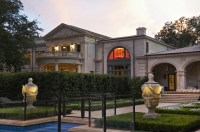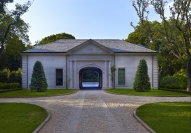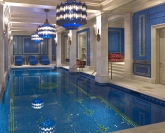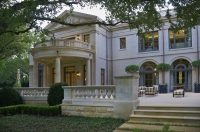The Oaks Residence
Dallas, TX
Mason Contractor:
Dee Brown, Inc.
![]()
Architect:
Larry E. Boerder Architects
General Contractor:
Sebastian & Associates
Suppliers:
Mezger Enterprises ; Bybee Stone Company, Inc.
Wall System: Cavity Wall: Stone Slab Veneer/Reinforced Concrete Block
Project Description
The recently completed Oaks Residence boasts of old world masonry with its Classic Italian Palladian Architecture. The Architect designed this 6¼ acre creekside property around the 29,000 square-foot home. The estate also incorporates a four-car garage inclusive of staff quarters, and a pool cabana/pavilion. Expansive areas of hardscape connect buildings on the property. The owner’s choice of property and willingness to invest in an estate valued in the tens of millions demanded the highest forms of function and appearance.
The main exterior cladding material was Texas Lueders limestone. It was used for typical wall panels but also for plinths, window surrounds, balustrade assemblies, solid columns, and cornices. In most projects, typical panels are 1¼” to 2” thick and simply use one anchor type. This job, however, used typical panels which were 3” thick. Rather than using typical anchors, the 3” veneer was built into the CMU backup wythe with “bonder” stones. This old-world method uses varied depths of stone veneer and CMU to physically build the two wythes together. Even with the “bonder” stones being used, stainless steel ties were still used as additional anchorage. The atypical pieces such as sills, pilasters, cornice, balusters, etc. were all anchored to the CMU backup with stainless steel anchors custom designed and engineered for the particular piece.
The stone to stone joint design was also atypical. Each joint measured only 1/8”, instead of the common ¼” to 3/8” generally seen, and was filled with lime mortar. This meant that fabrication tolerances for stone material were tighter and required special quality control to maintain during fabrication. It also meant that many of the anchorage pockets had to be relief-cut since the anchor thicknesses in many cases were thicker than the joints themselves.
Large stone column and window assemblies make up the east and west façades of this house. These were designed as solid load-bearing elements to support the pediment assemblies and to carry the structure above. The arches at the Pavilion were also designed as load-bearing elements. Pediment kneelers were cut from two separate carved pieces which were epoxied together. Weighing 7,200 lbs each, the kneelers had to be set with a 180 ton crane in order to reach over two very large existing oak trees. The garage and pool cabana were constructed with the same stone cladding system, and with similar load-bearing elements.
The unique exterior wall design yielded greater thermal mass, but also accommodated modern moisture-control products. The end result was a wall system designed to the architect’s aesthetic requirements, but with more substantial quality and thickness than normally seen. Also, the multiple wythe configuration, modern moisture control, and masonry materials meant that the function, lifespan, and sustainability will be much greater than typical construction.
All told, more than 2,000 stone fabrication tickets were generated. Stone and masonry work spanned 2 years, with total stone and masonry cost at end of project just under $5,000,000.
Date of Project Completion: September 2009
Awards
2010 UMCA Golden Trowel
Photography by DVDesign Group, Inc.
























